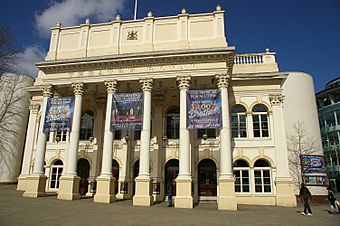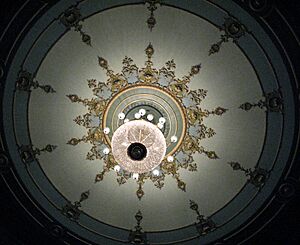Theatre Royal, Nottingham facts for kids

The theatre’s logo, incorporating the city’s coat of arms
|
|
 |
|
| Address | Theatre Square City Centre, Nottingham England |
|---|---|
| Owner | Nottingham City Council |
| Type | Proscenium arch theatre |
| Capacity | 1,186 (4 levels) |
| Current use | Touring venue |
| Construction | |
| Opened | 1865 |
| Years active | 31 years (since refurbishment) |
| Architect | Charles J. Phipps |
| Website | |
| http://www.trch.co.uk/ | |
The Theatre Royal in Nottingham, England, is a famous theatre. It sits right in the heart of Nottingham City Centre. The city council owns this theatre. It's part of a bigger complex that also includes the Royal Concert Hall. The Theatre Royal is a popular spot. It hosts many big shows. These include touring plays, opera, ballet, and even West End musicals. Every year, it also puts on a fun pantomime.
Contents
A Look Back: Theatre Royal's Story
The Theatre Royal was finished in 1865. It took only six months to build. The Nottingham Theatre Company paid £15,000 for it. This company was owned by John and William Lambert. They were lace makers. The theatre's classic front and Corinthian columns are still a major sight in Nottingham. Charles J. Phipps designed them.
The Theatre Royal opened on Monday, September 25, 1865. The first show was The School for Scandal by Sheridan. Over the years, many different managers ran the theatre. They put on all kinds of shows.
In 1897, a new company took over. It was called The Robert Arthur Theatres Ltd. This company owned theatres in other cities too. Robert Arthur was from Glasgow. His company presented many popular plays, operas, and pantomimes. But by 1912, the company ran into money problems. Then, Michael Simons became the chairman. His company, Howard & Wyndham, started running the theatres. In 1924, Moss Empires bought the theatre completely.
A famous play called The Scarlet Pimpernel (1903) first opened here. Fred Terry and Julia Neilson produced it. Later, it became a popular novel. This story helped create the idea of a 'masked hero'.
On October 6, 1952, the theatre made history. It hosted the world premiere of The Mousetrap. This play was on a tour before going to London's West End. The Mousetrap is now the longest-running play ever. Two years later, another play, The Manor of Northstead, also premiered here. It then moved to the West End.
In 1969, the city council bought the theatre. They spent £4 million to fix it up. It reopened in 1978. The theatre really needed repairs. Backstage conditions were known to be very poor.
Princess Anne officially reopened the theatre on June 6, 1978. She was very impressed. She said it was a huge improvement. She even mentioned the old place used to smell of gas! Inside, she met with city council leaders. She also unveiled a special plaque in the theatre's lobby.
How the Theatre Changed Over Time
Phipps' First Building (1865)
The theatre's grand entrance has six Corinthian columns. They are made of Ancaster stone. The Lamberts wanted a very impressive theatre. The entrance was placed to look great. It closed off a new street called Market Street. This street led from the Great Market Place.
The theatre could hold 2,200 people when it first opened. Here's how the seats were divided:
- Dress Circle - 250 seats
- Private Boxes - 50 seats
- Upper Boxes - 250 seats
- Pit - 850 seats
- Gallery - 800 seats
Matcham's Big Makeover (1897)
A famous theatre architect named Frank Matcham was hired. He was building the new Empire Palace of Varieties next door. The Theatre Royal closed for a few months in 1897. During this time, it was remodeled. New dressing rooms were built. This made space for the Empire theatre. Matcham also redesigned the inside of the theatre.
Matcham was a pioneer in using strong steel supports. He even patented his design. This allowed him to build balconies without pillars. Older theatres, like Phipps's, needed pillars to hold up the balconies. Without pillars, people could see the stage much better. The stage was lowered, and the seating levels were sloped more. This improved views for everyone. The theatre's capacity also grew to about 3,000 people.
What It Looks Like Now
Today, the theatre has four levels of seating. These are the stalls, dress circle, upper circle, and balcony. In total, it has 1,186 seats. There are seven bars inside the theatre. This includes The Green Room Cafe Bar on the ground floor. There's also The Restaurant on the dress circle level.
In late 2019 and early 2020, the theatre was refurbished. It was re-decorated and updated. You can easily get to the theatre by tram. The Royal Centre tram stop is right next to it.
Fun Pantomimes
The Theatre Royal puts on a pantomime every year. These shows often star local or national celebrities. Here are some of the recent pantomimes and their stars:
- 2022: Snow White with Joe Pasquale and Faye Tozer.
- 2021: Robin Hood with Tristan Gemmill and Matthew Kelly.
- 2020: Sleeping Beauty with Paul Chuckle and Flawless.
- 2019: Cinderella with Les Dennis and Gareth Gates.
- 2018: Peter Pan with Joe Pasquale and John Challis.
- 2017: Beauty and the Beast with Sherrie Hewson and Ben Richards.
- 2016: Jack and the Beanstalk with the Chuckle Brothers and Chico.
- 2015: Aladdin with Christopher Biggins and Simon Webbe.
- 2014: Snow White with Lesley Joseph and Sam Attwater.
- 2013: Peter Pan with David Hasselhoff and Su Pollard.
- 2012: Cinderella with John Partridge and Sheila Ferguson.
- 2011: Sleeping Beauty with Joe Pasquale.
- 2010: Aladdin with Stephen Mulhern.
- 2009: Jack and the Beanstalk with Nigel Havers and Jenna-Louise Coleman.
- 2008: Cinderella with Brian Conley.
- 2007: Peter Pan with Debra Stephenson and John Challis.
- 2006: Aladdin with Basil Brush and Christopher Biggins.
- 2005: Snow White with Claire Sweeney.
- 2004: Dick Whittington with Kevin Kennedy.
- 2003: Peter Pan with Joe Pasquale and Leslie Grantham.
- 2002: Cinderella with Bobby Davro.
- 2001: Aladdin with Cannon and Ball and Sooty.
- 2000: Jack and the Beanstalk with the Chuckle Brothers and Bonnie Langford.
- 1999: Snow White with Lionel Blair and Linda Lusardi.
- 1998: Dick Whittington with Lesley Joseph and John Nettles.
- 1997: Cinderella with Bradley Walsh.
- 1996: Peter Pan with Russ Abbot.
- 1993: Mother Goose with Frank Windsor.
- 1991: Cinderella with Anne Charleston.
- 1985: Aladdin with The Patton Brothers and Barbara Windsor.
- 1981: Aladdin with Barbara Windsor and Keith Harris.
- 1979: Cinderella with Windsor Davies.
- 1978: Mother Goose with John Inman.
- 1975: Robin Hood with The Patton Brothers.
- 1974: Jack and the Beanstalk with Little and Large.
- 1971: Cinderella with Dickie Henderson.
See also
- Royal Concert Hall, Nottingham
- Nottingham Playhouse
- Nottingham City Centre


